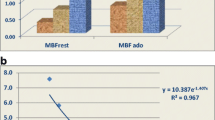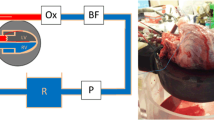Abstract
Introduction
Invasive methods for assessment of coronary microcirculatory function are time- and instrumentation-consuming tools. Recently, novel computer-assisted videodensitometric methods have been demonstrated to provide quantitative information on myocardial (re)perfusion. The aim of the present prospective study was to evaluate the accuracy of videodensitometry-derived perfusion parameters in patients with stable angina undergoing elective coronary angiography.
Methods
The study comprised 13 patients with borderline epicardial coronary artery stenosis (40–70%). Coronary flow reserve and index of microcirculatory resistance were measured by using an intracoronary pressure and temperature sensor-tipped guidewire. A videodensitometric quantitative parameter of myocardial perfusion was calculated by the ratio of maximal density (Gmax) and the time to reach maximum density (Tmax) of the time-density curves in regions of interest on conventional coronary angiograms. Myocardium perfusion reserve was calculated as a ratio of hyperemic and baseline Gmax/Tmax.
Results
At hyperemia a significant increase in Gmax/Tmax could be observed (p <0.0001). Significant correlations were found between myocardium perfusion reserve and coronary flow reserve (r =0.82, p =0.0008) and between hyperemic Gmax/Tmax and hyperemic index of microcirculatory resistance (r =−0.72, p =0.0058).
Conclusions
Videodensitometric Gmax/Tmax assessment seems to be a promising method to assess the myocardial microcirculatory state.
Similar content being viewed by others
References
Camici P.G., Crea F.N., Coronary microvascular dysfunction, N. Engl. J. Med., 2007, 356, 830–840
Knaapen P., Camici P.G., Marques K.M., Nijveldt R., Bax J.J., Westerhof N., et al., Coronary microvascular resistance: methods for its quantification in humans, Basic Res. Cardiol., 2009, 104, 485–98.
Kern M.J., Coronary physiology revisited: practical insights from the cardiac catheterization laboratory, Circulation, 2000, 101, 1344–1351
Fearon W.F., Balsam L.B., Farouque H.M., Caffarelli A.D., Robbins R.C., Fitzgerald P.J,, Novel index for invasively assessing the coronary microcirculation, Circulation, 2003, 107, 3129–3132
Aarnoudse W., Fearon W.F., Manoharan G., Geven M., van de Vosse F., Rutten M., et al., Epicardial stenosis severity does not affect minimal microcirculatory resistance, Circulation, 2004, 110, 2137–2142
Ng M.K., Yeung A.C., Fearon W.F., Invasive assessment of the coronary microcirculation: superior reproducibility and less hemodynamic dependence of index of microcirculatory resistance compared with coronary flow reserve, Circulation, 2006, 113, 2054–2061
van’t Hof A.W., Liem A., Suryapranata H., Hoorntje J.C., de Boer M.J., Zijlstra F., Angiographic assessment of myocardial reperfusion in patients treated with primary angioplasty for acute myocardial infarction: myocardial blush grade. Zwolle Myocardial Infarction Study Group, Circulation, 1998, 97, 2302–2306
Gibson C.M., Cannon C.P., Murphy S.A., Ryan K.A., Mesley R., Marble S.J. et al., Relationship of TIMI myocardial perfusion grade to mortality after administration of thrombolytic drugs, Circulation, 2000, 101, 125–130
Korosoglou G., Haars A., Michael G., Erbacher M., Hardt S., Giannitsis E. et al., Quantitative evaluation of myocardial blush to assess tissue level reperfusion in patients with acute ST-elevation myocardial infarction: incremental prognostic value compared with visual assessment, Am. Heart. J., 2007, 153, 612–620
Haeck J.D., Gu Y.L., Vogelzang M., Bilodeau L., Krucoff M.W., Tijssen J.G. et al,. Feasibility and applicability of computer-assisted myocardial blush quantification after primary percutaneous coronary intervention for ST-segment elevation myocardial infarction, Catheter Cardiovasc. Interv., 2010, 75, 701–706
Vogelzang M., Vlaar P.J., Svilaas T., Amo D., Nijsten M.W., Zijlstra F., Computer-assisted myocardial blush quantification after percutaneous coronary angioplasty for acute myocardial infarction: a substudy from the TAPAS trial, Eur. Heart. J., 2009, 30, 594–599
Ungi T., Ungi I., Jónás Z., Sasi V., Lassó A., Zimmermann Z. et al., Myocardium selective densitometric perfusion assessment after acute myocardial infarction, Cardiovasc. Revasc. Med., 2009, 10, 49–54
Ungi T., Zimmermann Z., Balázs E., Lassó A., Ungi I., Forster T. et al,. Vessel masking improves densitometric myocardial perfusion assessment, Int. J. Cardiovasc. Imaging, 2009, 25, 229–236
Pijls N.H., De Bruyne B., Smith L., Aarnoudse W., Barbato E., Bartunek J. et al., Coronary thermodilution to assess flow reserve: validation in humans, Circulation, 2002, 105, 2482–2486
Chelliah R., Senior R., An update on contrast echocardiography, Minerva Cardioangiol., 2009, 57, 483–493
Nagel E., Lima J.A., George R.T., Kramer CM., Newer methods for noninvasive assessment of myocardial perfusion: cardiac magnetic resonance or cardiac computed tomography?, JACC Cardiovasc. Imaging, 2009, 2, 656–660
Hachamovitch R., Berman D.S., Kiat H., Cohen I., Cabico J.A., Friedman J. et al., Exercise myocardial perfusion SPECT in patients without known coronary artery disease: incremental prognostic value and use in risk stratification, Circulation, 1996, 93, 905–914
Al-Mallah M.H., Sitek A., Moore S.C., Di Carli M., Dorbala S., Assessment of myocardial perfusion and function with PET and PET/CT, J. Nucl. Cardiol., 2010, 17, 498–513
Blankstein R., Di Carli M.F., Integration of coronary anatomy and myocardial perfusion imaging, Nat. Rev. Cardiol., 2010, 7, 226–236
Miller J.M., Rochitte C.E., Dewey M., Arbab-Zadeh A., Niinuma H., Gottlieb I. et al., Diagnostic performance of coronary angiography by 64-row CT, N. Engl. J. Med., 2008, 359, 2324–2336
Wijns W., De Bruyne B., Vanhoenacker P.K., What does the clinical cardiologist need from noninvasive cardiac imaging: is it time to adjust practices to meet evolving demands?, Nucl. Cardiol., 2007, 14, 366–370
Leung D.Y., Leung M., Non-invasive/invasive imaging: significance and assessment of coronary microvascular dysfunction, Heart, 2011, 97, 587–595
Korosoglu G., Riedle N., Erbacher M., Dengler T.J., Zugck C., Rottbauer W. et al., Quantitative myocardial blush grade for the detection of cardiac allograft vasculopathy. Am Heart J, 2010, 159, 643–651
Havers J., Haude M., Erbel R., Spiller P., X-ray densitometric measurement of myocardial perfusion reserve in symptomatic patients without angiographically detectable coronary stenoses, Herz, 2008, 33, 223–232
Pijls N.H., Van Gelder B., Van der Voort P., Peels K., Bracke F.A., Bonnier H.J. et al., Fractional flow reserve. A useful index to evaluate the influence of an epicardial coronary stenosis on myocardial blood flow, Circulation, 1995, 92, 3183–3193
Abaci A., Oguzhan A., Eryol N.K., Ergin A., Effect of potential confounding factors on the thrombolysis in myocardial infarction (TIMI) trial frame count and its reproducibility, Circulation,1999, 100, 2219–2223
Author information
Authors and Affiliations
Corresponding author
About this article
Cite this article
Nagy, F.T., Nemes, A., Szűcsborus, T. et al. Validation of videodensitometric myocardial perfusion assessment. cent.eur.j.med 8, 600–607 (2013). https://doi.org/10.2478/s11536-013-0168-3
Received:
Accepted:
Published:
Issue Date:
DOI: https://doi.org/10.2478/s11536-013-0168-3




